Last Updated on April 25, 2023 by Lisa Vargas
Imagine this scenario: You need to leave your home due to an emergency, and you have to survive on your own for an unknown amount of time. In this situation, having the knowledge to identify and consume edible wild plants could be the difference between life and death.
It’s a skill that may seem daunting or unnecessary, but in times of crisis, it’s critical to know how to forage for food. In this post, we’ll be discussing 10 edible wild plants that are commonly found in backyards, and how to identify and prepare them for consumption.
Knowing how to find and utilize these plants is not only important for emergency situations, but also for everyday life. Not only are they rich in nutrients, but they can also be a delicious addition to your meals.
It’s important to note that it’s always best to consult with an expert before consuming any wild plants, as some can be harmful if not prepared correctly. But with a bit of knowledge and practice, you can have the confidence to sustain yourself in the wild if needed.
So whether you’re a seasoned survivalist or just starting out, let’s dive into this topic and discover the natural bounty that surrounds us. Let’s get started!
10 Edible Wild Plants You Can Find in Your Backyard
It’s important to learn about some of the most common plants that can be easily foraged if you and your family find yourself in a situation where you are barricaded in your home or martial law is declared for a longer period of time. Here’s the list of 10 edible wild plants you can find in your backyard.
1. Dandelions

Dandelions are one of the most common and recognizable edible wild plants, and they’re a valuable addition to any survivalist’s diet. They’re packed with vitamins and minerals, including vitamins A, C, and K, as well as calcium and potassium.
Dandelions are a common wild edible plant that can be found in many areas, including meadows, fields, and lawns. Despite being seen as a pesky weed, dandelions are actually one of the most versatile and nutritious wild edible plants. As a prepper or survivalist, knowing how to identify and use dandelions can be a valuable skill in a survival situation.
Identification
The vivid yellow blossoms and unique circular seed heads of dandelions make them simple to identify. The dandelion plant has leaves that are up to a foot long and have razor-sharp edges. At the plant’s base, they are grouped in a rosette arrangement. Dandelion stems are hollow and when split can release a creamy fluid.
Dandelions come in a variety of species, some of which might be poisonous or unpleasant. The most popular safe kind for consumption is the common dandelion (Taraxacum officinale).
How To Eat Dandelions
Once you’ve picked your dandelion leaves, you can prepare them in a variety of ways. One of the easiest and most popular methods is to sauté them with garlic and olive oil. You can also use them in salads, soups, or stir-fries. For a more intense flavor, try blanching the leaves before sautéing them.
Dandelion roots are also edible and can be roasted and used as a coffee substitute. Simply dig up the roots, wash them thoroughly, and dry them in a warm, well-ventilated area. Once they’re dry and brittle, roast them in the oven or on a stovetop until they’re dark brown. Grind the roasted roots and brew them just like coffee.
Precautions
It’s important to note that some individuals may be allergic to dandelions, so it’s important to consume them in moderation and to test a small amount before consuming larger quantities. Additionally, be sure to avoid dandelions that have been sprayed with chemicals or are growing in contaminated soil.
Dandelions are a versatile and nutritious edible wild plant that can be easily found in most backyards. With a little bit of knowledge and preparation, you can turn these common weeds into a valuable food source in a survival situation.
2. Purslane
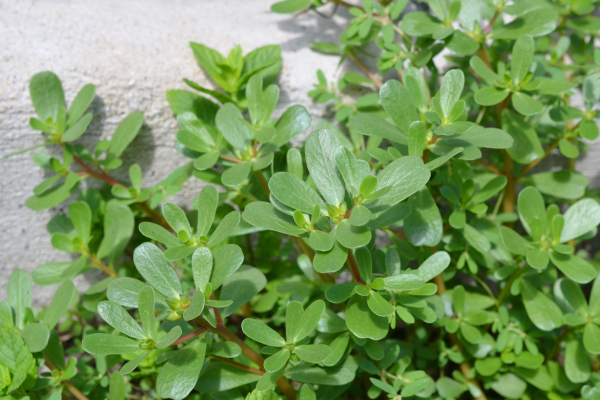
Purslane is a highly nutritious and versatile wild edible plant that is often found growing in gardens, lawns, and other cultivated areas. Its luscious, thick leaves are high in omega-3 fatty acids and vitamins A and C.
Identifying Purslane
Identifying purslane is relatively easy, as it has distinctively thick, succulent leaves that are shiny and smooth. The leaves are linked to a sturdy stalk and arranged in a rosette design.
Purslane can grow up to 12 inches in length, and it produces small yellow flowers in the summer months, that are also edible. Hardy and tolerant of arid environments, purslane is a wonderful addition to any survival garden.
How To Eat Purslane
Purslane is a versatile plant that can be used in a variety of dishes. One of the easiest ways to prepare purslane is to add it to salads or use it as a garnish. Its mild, slightly sour flavor pairs well with a variety of ingredients.
Purslane can also be sautéed with garlic and olive oil or used in soups and stews. When cooking, it’s important not to overcook purslane, as it can become slimy.
When harvesting purslane, it’s important to do so in the morning or evening when the leaves are less likely to wilt. Rinse the leaves thoroughly with cool water and pat dry before using. Purslane can be stored in the refrigerator for several days if wrapped in a damp paper towel and stored in a plastic bag.
Precautions
While purslane is a safe and nutritious edible plant, it’s important to avoid plants that have been sprayed with chemicals or are growing in contaminated soil.
Additionally, purslane may contain oxalic acid, which can be harmful in large quantities. However, the levels of oxalic acid in purslane are relatively low and should not pose a significant health risk.
Purslane is great for diets if you find yourself in a situation with little or no food. With its distinctive leaves and mild flavor, it’s a versatile and nutritious plant that can be used in a variety of dishes. As with all wild edible plants, it’s important to exercise caution and do your research before consuming them.
By learning how to identify and prepare wild plants like purslane, you can turn them into a valuable food source that could help you survive in emergency situations.
3. Chickweed
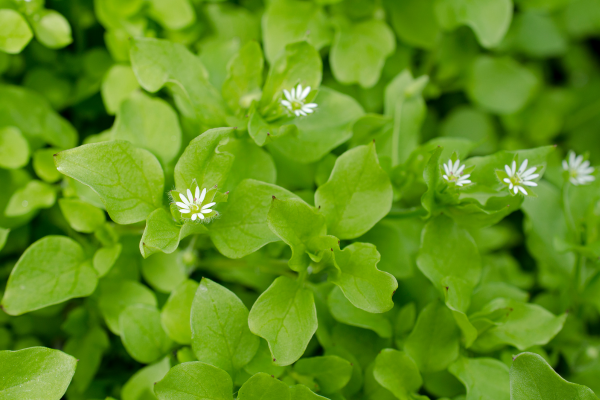
Chickweed is a common wild edible plant that can be found growing in many areas, including gardens, lawns, and wooded areas. It is an important component of any survivalist’s diet because it has a moderate, somewhat sweet taste and is packed full of with vitamins and minerals.
Identifying Chickweed
Identifying chickweed is relatively easy, as it has small, oval-shaped leaves that are attached to a thin stem. The stem is often covered in small white hairs, and the plant produces small, white flowers in the spring and summer months. Chickweed can grow up to 16 inches in length, and it thrives in moist, shady areas.
Chickweed is a fast-growing plant that is easy to identify and harvest. It is the ideal accompaniment to salads and other raw meals because to its delicate leaves and stems. When picking chickweed, it’s important to be mindful of where it is growing. Avoid plants that have received pesticide or herbicide treatments, as well as plants that are thriving in environments that might be polluted.
How To Eat Chickweed
Chickweed is a versatile plant that can be used in a variety of dishes. It can be either raw or cooked, and its mild, somewhat sweet flavor blends well with a variety of dishes. One of the easiest ways to prepare chickweed is to add it to salads or use it as a garnish. It can also be sautéed with garlic and olive oil or used in soups and stews.
Chickweed can be used in a variety of recipes and provides valuable nutrition to any meal. Additionally, it has a lot of antioxidants, which may strengthen the immune system and lessen inflammation. To keep chickweed fresh when storing it, be sure to wrap it in a wet paper towel and put it in a plastic bag in the refrigerator
Precautions
While chickweed is a safe and nutritious edible plant, it’s important to avoid plants that have been sprayed with chemicals or are growing in contaminated soil. Additionally, some individuals may be allergic to chickweed, so it’s important to eat it in moderation and to test a small amount before consuming larger quantities.
When picking wild plants like chickweed, it’s important to exercise caution and to be mindful of the plants’ surroundings. Always do your research and be sure to properly identify the plant before consuming it. By learning how to identify and prepare wild plants like chickweed, you can turn them into a valuable food source that could help you survive in emergency situations.
4. Lamb's Quarters
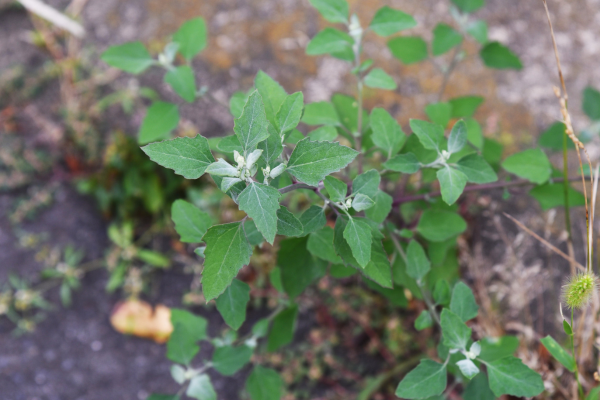
Lamb’s Quarters, also known as wild spinach, is a leafy green that is often found growing in gardens and fields. Despite being considered a weed by many, lamb’s quarters is a versatile and nutritious wild edible plant that can provide a valuable source of food in a survival situation.
Identification
Lamb’s quarters are easy to identify, with their distinctive diamond-shaped leaves and silvery-green color. The leaves have a mild spinach-like flavor and are a little woolly. The shrub, which may reach a height of 6 feet, blooms in the summer with tiny green flowers. Lamb’s quarters can be found in a variety of locations, including gardens, fields, and disturbed areas.
Nutritional Value
One of the healthiest wild edible plants is lamb’s quarters, which has high levels of calcium, iron, potassium, and the vitamins A, C, and K. Antioxidants found in the leaves can aid in defending the body against free radicals and oxidative stress.
In addition to the leaves, the seeds of the lamb’s quarters plant are also edible and can be ground into a flour for baking. The seeds have a nutty taste and are a good source of protein and fiber.
How To Eat Lamb's Quarters
Lamb’s quarters can be used in a variety of different ways, making them a versatile ingredient in the kitchen. The leaves can be cooked like spinach or eaten raw in salads. For added nourishment, they can also be added to stews, stir-fries, and soups.
The lamb’s quarters plant’s new branches, flower buds, and leaves can all be consumed.The immature stalks can be used in place of asparagus because of their sensitive feel. The flower buds can be steamed or sautéed and have a mild flavor that pairs well with other vegetables.
In addition to the leaves and shoots, the seeds of the lamb’s quarters plant can be ground into a flour for baking. The flour has a nutty flavor and can be used to make bread, pancakes, or other baked goods.
Precautions
While lamb’s quarters are safe to eat, it’s important to avoid picking them from areas that have been sprayed with pesticides or herbicides. It’s also important to avoid harvesting lamb’s quarters from areas that may have been contaminated with pollutants, such as roadsides or industrial sites.
5. Wild Strawberry
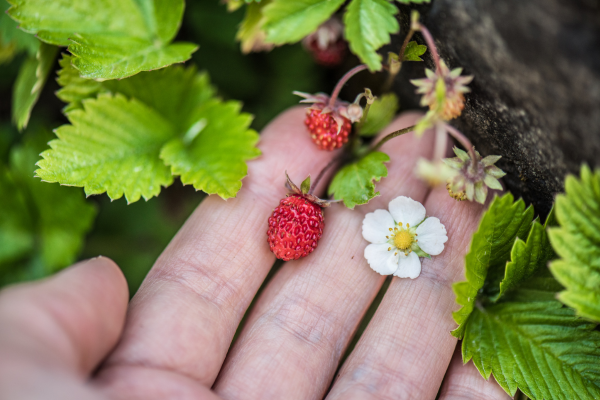
Small but flavorful, wild strawberries can be found in a range of landscapes, including meadows, forests, and even cities. Knowing how to identify and use wild strawberries can be a valuable skill in a survival situation.
Identification
Wild strawberries are easily recognizable by their small size and bright red color. The leaves are toothed and can grow up to 3 inches long. The flowers are white and can be found in clusters at the base of the plant. Wild strawberries can be found in many different situations and grow close to the ground.
Wild strawberries come in a variety of species, some of which might be poisonous or bitter. The most commonly consumed species is the common wild strawberry (Fragaria virginiana), which is safe to eat.
Nutritional Value
Wild strawberries are a fantastic complement to any diet since they are loaded with nutrients. They are an excellent source of potassium, folate, and vitamin C. Antioxidants found in wild strawberries can aid in the body’s defense against free radicals and oxidative stress.
How To Eat Wild Strawberry
Wild strawberries are a flexible ingredient because they may be consumed both raw and cooked. They complement many different foods with their sweet, tart flavor. Wild strawberries can be used to make jams and jellies, dessert toppings, and salad dressings.
The leaves of the wild strawberry plant can be consumed in addition to the fruit. The leaves can be used to create tea or used to salads; they have a pleasant, fruity flavor. They can be a good source of nourishment and are also high in vitamin C.
Precautions
While wild strawberries are safe to eat, it’s important to avoid picking them from areas that have been sprayed with pesticides.
When foraging for wild strawberries, it’s important to be aware of other plants that may look similar. Some toxic plants, such as the mock strawberry (Duchesnea indica), can be mistaken for wild strawberries. The mock strawberry has yellow flowers instead of white, and the fruit has a less pronounced aroma.
6. Plaintain
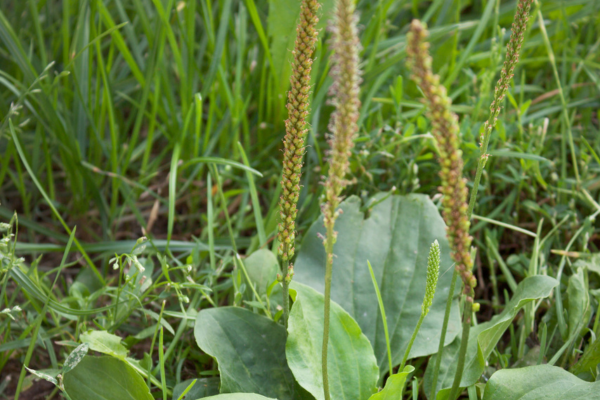
The Plantain Plant is a common wild edible plant that can be found growing in many areas, including lawns, gardens, and other disturbed areas. It has a slightly bitter taste and is filled with vitamins and minerals.
Identifying Plantain
Plantain is a common wild edible plant that is easy to identify once you know what to look for. It has distinctive oval-shaped leaves that are attached to a thick stem. The leaves are smooth and have prominent veins that run parallel to the stem. The stem itself is quite thick and can range in color from green to brown. Plantain can grow up to 12 inches in length and produces small, greenish-white flowers in the summer months.
When identifying plantain, it’s important to note the plant’s distinctive features. The oval-shaped leaves, thick stem, and prominent veins make it easy to distinguish from other plants. Additionally, the plant’s habit of growing in areas that have been disturbed by human activity, such as lawns and gardens, can help to narrow down the search.
One common mistake that people make when identifying plantain is confusing it with the poisonous plant known as “lily of the valley.” Although the two plants initially have a similar appearance, plantain has a bitter taste and small, greenish-white blossoms, whilst lily of the valley has bell-shaped petals and a distinctive aroma.
It’s usually smart to be cautious and stay clear of consuming a plant if you’re unclear of its identification.
how To Eat Plantain
Plantain is a versatile plant that can be used in a variety of dishes. Its slightly bitter flavor pairs well with a variety of ingredients, and it can be eaten raw or cooked. One of the easiest ways to prepare plantain is to add it to salads or use it as a garnish. It can also be sautéed with garlic and olive oil or used in soups and stews.
Plantain is a highly nutritious plant that is packed with vitamins and minerals. It is especially high in vitamins A and C, as well as calcium and potassium. When harvesting plantain, be sure to rinse the leaves thoroughly with cool water and pat dry before using. It can be stored in the refrigerator for several days if wrapped in a damp paper towel and stored in a plastic bag.
Precautions
While plantain is a safe and nutritious edible plant, it’s important to avoid plants that have been sprayed with chemicals. Additionally, some individuals may be allergic to plantain, so if you decide to eat it, do so in moderation and test a small amount before consuming larger quantities.
Like all other wild edible plants on this list, make sure you are 100% sure that it is the edible plantain plant and it isn’t near any pesticides.
7. Wood Sorrel
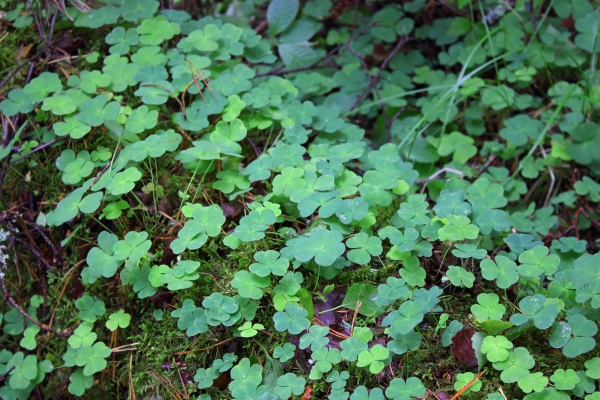
Wood Sorrel is a wild edible plant that is often overlooked, but it’s a valuable addition to your diet if you can find it. It adds a sour, lemony flavor to foods and is loaded with vitamins and minerals, making it a healthy and delicious addition to salads.
Identifying Wood Sorrel
Identifying wood sorrel is relatively easy, as it has distinctive heart-shaped leaves that are attached to a thin stem. The leaves are light green and have a distinctive sour taste. The delicate stem of the plant can be any shade from bright green to reddish brown.
One of the most distinguishing features of wood sorrel is its flowers. They are small, delicate, and can range in color from white, yellow and pink. The flowers have five petals and are cup-shaped. They bloom from late spring to early fall, depending on the location and climate.
Wood sorrel grows in moist, shady areas, such as woodlands, meadows, and along riverbanks. It is a plant that grows fairly quickly and can reach up to 12 inches in length, but it is usually much smaller. The plant produces a cluster of leaves close to the ground, with the stem rising up from the center.
It’s important to be mindful of where wood sorrel is growing when harvesting it. Don’t eat the plants if they have been treated with pesticides or herbicides, as well as plants that are growing in areas that may be contaminated with pollutants.
When identifying wood sorrel, it’s important to note the plant’s distinctive features. The heart-shaped leaves, delicate stem, and sour taste make it easy to distinguish from other plants. Additionally, the plant’s habit of growing in moist, shady areas, and the delicate cup-shaped flowers can help to narrow down the search.
One common mistake that people make when identifying wood sorrel is confusing it with clover. While the two plants may look similar at first glance, wood sorrel has heart-shaped leaves and a sour taste, while clover has oval-shaped leaves and a mild flavor.
If you’re unsure about the identification of a particular plant, don’t eat it!
How To Eat Wood Sorrel
Wood sorrel is a versatile plant that can be used in a variety of dishes. Its tart, lemony flavor pairs well with a variety of ingredients, and it can be eaten raw or cooked.
One of the easiest ways to prepare wood sorrel is to add it to salads or use it as a garnish. Simply rinse the leaves thoroughly with cool water and pat dry before using. Wood sorrel can also be used in sandwiches or wraps as a tangy addition to the filling.
If you prefer to cook with wood sorrel, it can be sautéed with garlic and olive oil or used in soups and stews. The leaves can also be used to make a flavorful pesto, which can be used as a spread or added to pasta dishes.
It’s important to note that wood sorrel should be used in moderation, as its high oxalic acid content can be harmful in large quantities. Oxalic acid can interfere with the absorption of calcium, and can also cause kidney stones in susceptible individuals. However, as long as wood sorrel is consumed in moderation, it is a safe and nutritious addition to your diet.
Precautions
While wood sorrel is a safe and nutritious edible plant, it’s important to avoid plants that have been sprayed with chemicals or are growing in contaminated soil. Additionally, some individuals may be allergic to wood sorrel, so it’s important to consume it in moderation and to test a small amount before consuming larger quantities.
8. Nettles
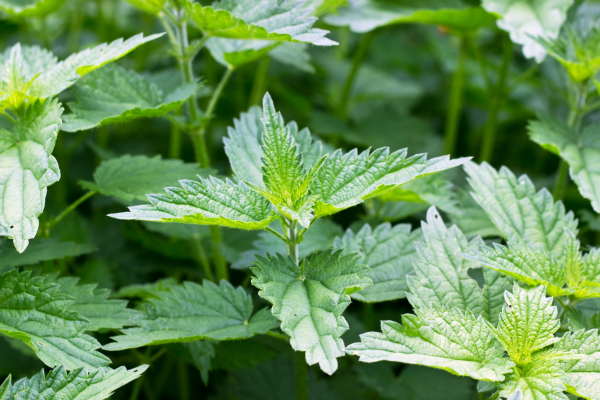
Nettles are a valuable but little-known wild food plant that grows in your backyard or nearby. They can be a nourishing supplement to your diet in a survival situation because they are loaded with vitamins and minerals.
They are also infamous for having stinging hairs, which if handled incorrectly, can result in a terrible rash. In this section, we’ll go over identifying nettles, harvesting them safely, and various dishes you can make with this adaptable wild plant.
Identifying Nettles
Nettles are relatively easy to identify due to their distinctive serrated leaves and stinging hairs. The plant has green, pointed, oval leaves that are positioned across the stem from one another. The leaves can range in size from 1 to 6 inches long and have a rough texture due to the presence of tiny hairs.
The stem of the nettle plant is covered in stinging hairs, which release a painful toxin when touched. The hairs are found on the stem and the underside of the leaves. The leaves also have a unique heart-shaped base that tapers to a point.
Nettles can grow as tall as 6 feet and prefer moist, fertile soil. They are often found growing along riverbanks, in meadows, and along roadsides. The plant blooms in the summer and produces small clusters of greenish-white flowers.
When harvesting nettles, it’s important to wear protective gloves and long sleeves to avoid the stinging hairs. Early spring is the ideal time to pick nettles because they are still young and delicate. The leaves get more fibrous and stiff as the plant ages, making them less tasty.
By learning how to identify nettles, you can confidently harvest them for use in a variety of dishes. It’s important to always be cautious and wear protective gear when handling this plant, as the stinging hairs can cause a painful rash.
How To Eat Nettles
Once you have found your nettles, it’s important to properly prepare them for consumption. The leaves and stems should be carefully cleaned to get rid of any dirt before cooking.
Blanching nettles for one to two minutes in hot water is a typical preparation method. This process neutralizes the stinging hairs and makes them safe to handle and consume. Once blanched, the nettles can be sautéed with garlic and olive oil or added to soups and stews.
Another popular way to prepare nettles is to dry them and make tea. To completely dry the nettles, just hang them upside-down in a cool, dry area. Then, crush the leaves and steep them in hot water for a few minutes.
Nettles can also be used as a filling for savory pies or added to scrambled eggs for a nutritious breakfast.
It’s crucial to use caution while gathering any wild plant that can be eaten and stay away from places that may have been sprayed with pesticides or herbicides. Additionally, be mindful of the plant’s surroundings and avoid harvesting from areas that may be contaminated with pollutants.
You may take advantage of the nutritional benefits of nettles and include them in your supply of survival food by knowing how to properly prepare and cook them.
Precautions
When harvesting nettles, it’s important to wear protective gloves and long sleeves to avoid the stinging hairs. A painful rash that lasts for several hours or even days can be brought on by the hairs.
However, once the leaves have been blanched or cooked, they are safe to handle and consume.
The use of pesticides and herbicides, as well as any regions that can be contaminated with pollutants, should also be avoided when picking nettles.
9. Mulberries
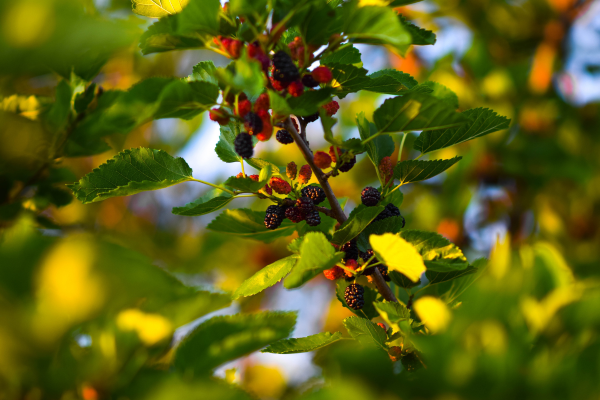
One plant to be on the lookout for is the mulberry tree. The leaves can be utilized in a number of cuisines and are edible in addition to the delectable berries. Whether you stumble upon a wild mulberry tree or have the opportunity to grow one yourself, incorporating this nutritious and versatile plant into your survival diet is a smart choice.
Identifying Mulberries
Mulberry trees can be identified by their unique leaves and fruit. The leaves of the mulberry tree are typically large, glossy, and have a heart-shaped or oval shape. They are usually between 2 and 6 inches long and have a serrated edge.
The distinctive hue of the leaves, which can range from dark green to light green and occasionally even have a bluish tint, is one method to spot a mulberry tree.
The fruit of the mulberry tree is also unique and can help in identification. The fruit is a small, round or oblong berry that looks similar to a blackberry or raspberry. It can vary in color from deep red to dark purple and sometimes black. The fruit typically ripens in the summer months, usually around late June to early August, depending on the climate and location.
When identifying mulberry trees, it’s essential to note that they can be mistaken for other types of trees, such as black cherry or black walnut. One way to differentiate mulberry trees from others is by examining the bark. Mulberry trees have a smooth gray-brown bark, while black cherry and black walnut trees have rougher and darker bark.
It’s also important to note that there are different types of mulberry trees, including white, red, and black mulberries. White mulberries have smaller fruit, while red and black mulberries have larger fruit. However, all three types of mulberry trees have similar leaves and can be identified using the same methods.
Overall, identifying a mulberry tree is relatively easy once you know what to look for. By examining the tree’s leaves and fruit, you can determine if it’s a mulberry tree or another type of tree. With this knowledge, you can confidently harvest the fruit and leaves to add to your survival diet.
How To Eat Mulberries
Mulberries can be eaten fresh or used in a variety of recipes. They have a sweet, juicy flavor and can be used as a substitute for other berries in recipes.
One simple way to enjoy mulberries is to eat them fresh with a sprinkle of sugar or honey. If we are in a lockdown situation, you could use them in smoothies, salads, and desserts. But since you more than likely will be eating these during a survival mode, they can be used to vary the flavor of other foods and add some variety.
Put mulberries in a shallow jar and keep in the fridge for up to a week. Additionally, they can be frozen for longer preservation.
Additionally, mulberry leaves are also edible and can be used in a variety of dishes. They have a slightly sweet flavor and can be used as a substitute for spinach in recipes. They can also be dried and used to make tea.
When picking mulberry leaves, it’s important to select young, tender leaves, as older leaves can be tough and fibrous. The leaves can be used to soups, stews, and stir-fries and consumed raw or cooked.
Mulberries are a delicious and nutritious wild edible that is worth seeking out if you are in a survival situation. By learning how to identify and harvest them, you can add another valuable food source to your survival arsenal.
Precautions
One word of caution when harvesting mulberries: the tree can release a white, milky sap when the fruit is picked or the branches are cut. This sap can cause skin irritation, so it’s important to wear gloves and long sleeves when harvesting mulberries.
10. Wild Garlic
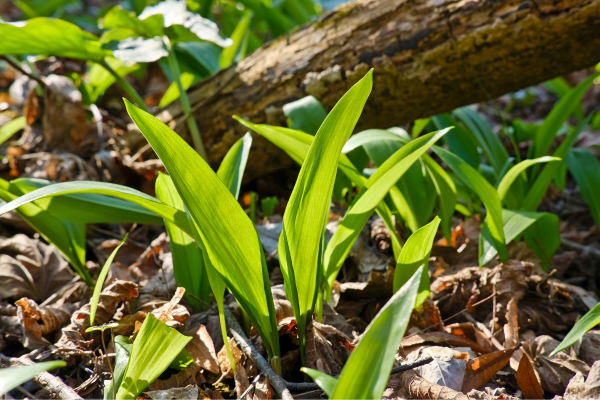
When it comes to wild edibles, one plant that often gets overlooked is wild garlic. Wild garlic is an essential component to any survival diet, despite the fact that it may not be as well recognized as some of the other plants on our list.. In this section, we will explore the benefits of wild garlic as a wild edible and provide practical tips for identifying, harvesting, and preparing this versatile plant.
Wild Garlic Identification
Wild garlic is a member of the Allium family, which also includes onions, chives, and shallots. It can be identified by several key features.
First, the plant has long, narrow leaves that grow from a bulbous root. The leaves are usually around 10-20 inches long and have a flat, smooth surface.
Secondly, wild garlic has a pungent garlic smell and taste. Crushing a leaf or bulb and smelling it can help you identify a plant if you’re not sure if it’s wild garlic.
The bulbs of wild garlic are small and white, similar in appearance to those of cultivated garlic, although they are smaller. The flowers of wild garlic are small and white or pink and typically bloom in the late spring or early summer.
When identifying wild garlic, it’s important to be cautious and make sure you are not mistaking it for other plants that may be toxic or harmful. While some plants, like Lily of the Valley and Autumn Crocus, resemble wild garlic, eating them can be extremely harmful to your health. It’s essential to do your research and be confident in your identification before consuming wild garlic.
How to Eat Wild Garlic
Wild garlic is a versatile plant that can be used in a variety of dishes. The leaves can be chopped up and used as a garnish or added to salads, while the bulbs can be chopped up and used as a substitute for garlic in recipes.
The blooms can also be added to salads to provide color or used as a garnish. Since wild garlic has a potent flavor, it’s better to start with a small amount and add more as necessary.
Precautions
While wild garlic is generally safe to eat. Make sure to properly identify the plant before consuming it. Some plants look similar to wild garlic but can be toxic.
Make sure you only gather wild garlic from places that haven’t received chemical applications or been exposed to contaminants.
Final Thoughts
It’s important to learn about edible plants in the wild just in case you find yourself in a situation with little or no food. Whether it’s a bug in or bug out situation, the more food sources you have the better!
